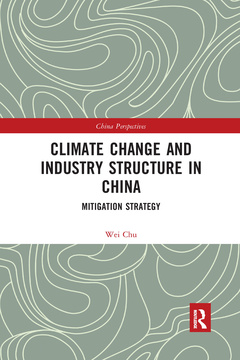Description
Climate Change and Industry Structure in China
Mitigation Strategy
China Perspectives Series
Author: Wei Chu
Language: English
Subjects for Climate Change and Industry Structure in China:
Keywords
Marginal Abatement Cost; Directional Distance Function; Energy Industry; Output Distance Function; Environmental Study; Undesired Output; Sustainability; Shadow Price; industrial development; Desired Output; contaminant disposal modeling; Energy Conservation; climate change negotiations; Emission Reduction Potential; Chinese cities; Distance Function; emission reduction; Gdp Output; GHG; Emission Reduction Target; Parameterized Distance Function; Per-capita Gdp; Gdp Loss; Bad Output; Marginal Cost Reduction; Energy Efficiency; Carbon Tax Rate; DEA Method; Lower Marginal Abatement Costs; CGE Model; Industrial Structure Adjustment; SFA; Emission Reduction Obligations
Publication date: 09-2021
· 15.6x23.4 cm · Paperback
Publication date: 02-2020
· 15.6x23.4 cm · Hardback
Description
/li>Contents
/li>Readership
/li>Biography
/li>
In order to effectively address global warming, many countries have significantly reduced the amount of carbon dioxide emissions that are put into the atmosphere. From the perspective of industrial structure, this volume examines the emission reduction potentials and abatement costs in China. By making an empirical analysis of the emission reduction, the author proposes some practical strategies.
The book comprehensively summarizes related theories and research of contaminant disposal modeling, and estimates the shadow price of interprovincial CO2 emissions, the emission reduction potential of different regions, and the marginal emission reduction cost based on the parametric model. It finally puts forward the strategy to adjust the industrial structure in China.
The book hence provides solid evidence for policy-makers to help mitigate CO2 emissions through industrial restructuring strategy.
List of figures. List of tables. Preface PART I:Emission Reduction Analysis Chapter 1 Literature Review of Contaminant Disposal Modeling under the Productivity Framework Chapter 2 Interprovincial CO2 shadow price research based on parametric model Chapter 3 Regional Decomposition of CO2 Emission Reduction Potential and Emission Reduction Targets Chapter 4 Research on CO2 marginal abatement cost in Chinese cities PART II: Strategic Response Chapter 5 Industrial restructuring strategy to mitigate and control CO2 emissions References. Index
Wei Chu is a professor at Renmin University of China. His research focuses on the analysis of energy efficiency, evaluation of abatement cost of pollutants, and the residential energy demand.




